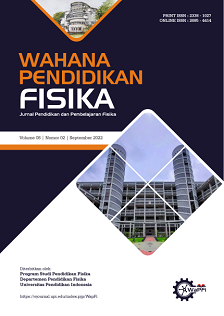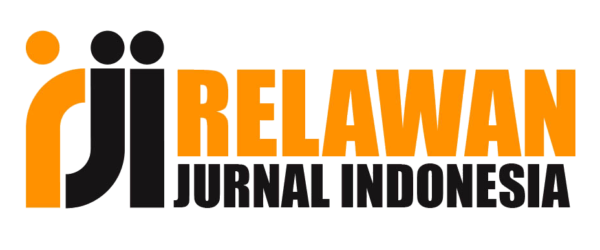Implementation of STEM integrated problem based learning model to improve student creativity
Abstract
Keywords
Full Text:
PDFReferences
Adawiyah, R., Harjono, A., Gunawan, G., & Hermansyah, H. (2019). Interactive e-book of physics to increase students’ creative thinking skills on rotational dynamics concept. Journal of Physics: Conference Series, 1153, 012117.
Apriliana, M. R., Ridwan, A., Hadinugrahaningsih, T., & Rahmawati, Y. (2018). Pengembangan Soft Skills Peserta Didik melalui Integrasi Pendekatan Science, Technology, Engineering, Arts, and Mathematics (STEAM) dalam Pembelajaran Asam Basa. JRPK: Jurnal Riset Pendidikan Kimia, 8(2), 42–51.
Conradty, C., & Bogner, F. X. (2018). From STEM to STEAM: How to Monitor Creativity. Creativity Research Journal, 30(3), 233–240.
Dewi, H. R. (2017). Peningkatan ketrampilan berfikir kreatif siswa melalui penerapan inkuiri terbimbing berbasis STEM. Prosiding SNPF (Seminar Nasional Pendidikan Fisika). 47-53
Ernawati, Halim, A., & Syukri, M. (2020). Integration of Problem Based Learning (PBL) and Engineering is Elementary (EiE) to improve students’ creativity. Journal of Physics: Conference Series, 1460(1).
Farwati, R., Permanasari, A., Firman, H., & Suhery, T. (2018, March). Integrasi problem based learning dalam STEM education berorientasi pada aktualisasi literasi lingkungan dan kreativitas. In Seminar Nasional Pendidikan IPA Tahun 2021, 1(1). 198-206.
Hanif, S., Wijaya, A. F. C., & Winarno, N. (2019). Enhancing Students’ Creativity through STEM Project-Based Learning. Journal of Science Learning, 2(2), 50.
Kemendikbud, P. W. (2017). Pendidikan karakter dorong tumbuhnya kompetensi siswa abad 21.
Manobe, S. M., & Wardani, K. W. (2018). Peningkatan kreativitas belajar ipa menggunakan model problem based learning pada siswa kelas 3 SD. Didaktika Dwija Indria.
Ningsih, S. I. P. (2020). Penerapan model pembelajaran PBL terintegrasi STEM untuk meningkatkan aktivitas dan hasil belajar peserta didik di kelas XII IPA 5 SMAN 7 Padang. Pillar of Physics Education.
Pratiwi, Y., Yulia, S. R., & Ramli, R. (2021). Validity of physics student e-book based on the STEM approach to improve knowledge competence. Journal of Physics: Conference Series, 1876(1), 012031.
Purwaningsih, E., Sari, S. P., Sari, A. M., & Suryadi, A. (2020). The Effect of STEM-PjBL and Discovery Learning on Improving Students’ Problem-Solving Skills of Impulse and Momentum Topic. Jurnal Pendidikan IPA Indonesia, 9(4), 465–476.
Sugiyono. (2019). Metode Penelitian Kuantitatif, Kualitatif, dan R&D. Alfabeta.
Vistara, M. F., Asikin, M., Ardiansyah, A. S., & Pudjiastuti, E. (2022, February). Problem Based Learning Berorientasi STEM Context Terhadap Kemampuan Berpikir Kreatif Matematika Siswa. In PRISMA, Prosiding Seminar Nasional Matematika, 5(1), pp. 451-460.
Zayyinah, Z., Erman, E., Supardi, Z. A., Hariyono, E., & Prahani, B. K. (2022, January). STEAM-integrated project based learning models: Alternative to improve 21st century skills. In Eighth Southeast Asia Design Research (SEA-DR) & the Second Science, Technology, Education, Arts, Culture, and Humanity (STEACH) International Conference (SEADR-STEACH 2021) (pp. 251-258). Atlantis Press.
Zubaidah, S. (2019). Memberdayakan keterampilan abad ke-21 melalui pembelajaran berbasis proyek. Seminar Nasional Nasional Pendidikan Biologi, 1(2). 1-19.
DOI: https://doi.org/10.17509/wapfi.v10i1.55082
Refbacks
- There are currently no refbacks.
Copyright (c) 2025 Universitas Pendidikan Indonesia (UPI)

This work is licensed under a Creative Commons Attribution-ShareAlike 4.0 International License.
The Journal Wahana Pendidikan Fisika http://ejournal.upi.edu/index.php/WapFi/ is licensed under a Creative Commons Attribution-ShareAlike 4.0 International License
The Journal WaPFi (Wahana Pendidikan Fisika).
All rights reserverd. pISSN 2338-1027 eISSN 2685-4414
Copyright © Faculty of Mathematics and Science Education (FPMIPA) Universitas Pendidikan Indonesia (UPI)










